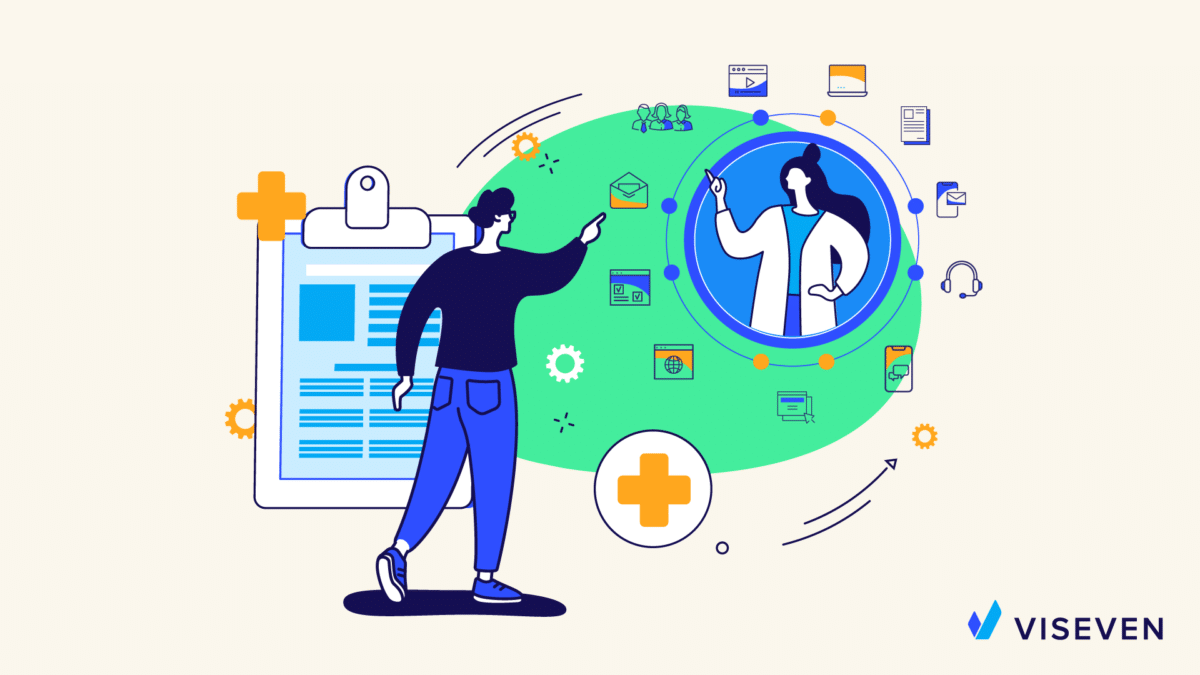Using omnichannel approach to achieve better HCP engagement: how does it work?

The pharmaceutical industry has talked about improving communication with HCPs for decades. While even several years ago, “closing the loop” was routinely equaled to traditional rep calls plus maybe a couple of emails, things have changed a lot recently. After the seismic shift of 2020, when the F2F variable temporarily left the equation, one thing became obvious: one-way communication (pharma speaks, HCPs listen) is no longer enough. Where is the guarantee the physicians do hear the message? Where is the value they are expecting? Establishing real, reciprocal HCP engagement is a challenge, yes. However, an increasing number of pharma organizations are using digital and omnichannel approach to resolve it – and successfully so.
HCP engagement? Customer experience is the key
To understand how to achieve genuine HCP engagement, it is helpful to define what it really is. Nodding at a representative or liking a pharma brand’s social media post – does this count? How far does the interaction really need to go to be considered significant for the overall communication funnel?
In reality, it makes sense to define engagement as either a two-way interaction (HCP actively responding to pharma), or any event that can potentially lead to such an interaction (e.g., a physician downloading materials from a portal or subscribing to a service).
From the HCP’s viewpoint, all of this happens within a certain “landscape” – their overall experience with the brand. At some point, when this customer experience attains a certain level of value to the HCP, they actively engage to get more. There are two prerequisites:
- The value already received from the experience (proof that the brand can offer more), e.g., a fruitful conversation with a rep or an interesting webinar
- The “promised” value – i.e., what the doctor can get if they only click that CTA button or ask the rep/MSL a question, etc.
The effects of a well-constructed customer experience are hard to underestimate. In recent research by McKinsey (immunologists, n=600), the doctor’s satisfaction with “prescription journey” (in HCP-to-patient and HCP-to-pharma aspects) had the power to almost double the likelihood of prescribing the product.
In other words, the overall experience interacting with the brand (in this case, via the representative) influenced the decision making roughly as much as the convenience factor while leading the patient.
Interestingly, this refers to a “rep-only” or “rep-led” scenario. Seeing as how digital resources and channels are gaining more weight and credibility (for example, 46% HCPs reported to trust branded professional web resources in 2019), the power of a coordinated omnichannel experience would be even more impressive.
But pharma already has a number of digital channels at disposal. Why is the problem still not obsolete? What could be improved?
What areas of improvement are still active?
Even though most organizations are, by now, using at least several forms of digital communication (tools, channels), there are factors that undermine the effort when it comes to HCP engagement. Drawing on Viseven’s experience, the most typical ones are as follows:
- Attempt to “squeeze” as much as possible into a single touchpoint. A tradition from F2F era, when the rep was supposed to deliver a list of obligatory messages within the 2-7 minutes of the call – and an unnecessary constraint in an omnichannel environment. With proper organization, the information to deliver can be split across touchpoints and delivered in the sequence most likely to get the HCP engaged.
- Lack of personalization. While a “one-size-fits-all” approach to messaging and content may sound temptingly simple, it no longer works well. Other industries, including retail, have raised the bar of expectations for customer experience.
- Siloed channels. The digital maturity stage immediately preceding omnichannel – “multichannel” really used to presuppose broadcasting the same messages across different channels without actual interconnection or traceability across them. However, this approach severely limits the marketer and only allows to operate in broad, crude segments.
Addressing these three areas of improvement at once is the essence of the omnichannel approach as it has emerged lately.
Omnichannel in pharma: what is it, actually?
Compared to simply having multiple channels, an omnichannel approach presupposes integration and interconnection between these channels. This is the next stage of strategic development, empowered by modern technology to connect the once-separate online and offline platforms into a single, observable and manageable whole.
From the HCP’s perspective, this connection between the channels means they are no longer “bombarded” by the same messages in different situations (reps, emails, messengers, web) but rather enjoy a cohesive, meaningful experience with the brand.
For the marketer, this approach allows to truly coordinate the channels and touchpoints and arrange the experiences delivered to the HCP. By knowing what the certain physician (individual or group) has been exposed to prior to the next touchpoint, and what the feedback was, the marketer can provide the experience that will engage with more probability.
Essentially, the integration of channels and cross-channel campaigning based on data, insights and automation provides the possibility of choice at multiple levels.
By having a 360-degree outlook on the target audience, the brand can deliver the right message or information in the right context, and via the right channel at every touchpoint. For example, the understanding of where exactly in the adoption funnel the HCP is right now, the marketer can choose to offer them the information they need at this stage. At the same time, the HCP make choices of their own, based on their interests, needs, and other individual characteristics.
These choices contribute to the pool of data that the marketer can then use to provide even better experiences, further reinforcing the connection.
Technology and mindset
The omnichannel approach is powered by technology, which includes integrated digital tools, Marketing Automation System, and (increasingly) even ML-based tools to account for large amounts of data.
At the same time, using omnichannel is also linked to a change in mindset when it comes to operating the entire system. Omnichannel pharma marketing requires the ability to think in terms of customer journeys – and making them automated.
Tools help in this process; marketing automation platforms offer journey planners that allow creating of automated flows, where the HCP’s decisions (clicks, reactions, subscribes, etc.) serve as disambiguations in the flow. A certain event (triggered by the HCP) essentially “tells” the algorithm to offer the next touchpoint. Of course, it is best at least at the initial stage of implementation to have a skilled professional arrange the journeys for maximum efficiency.
How to increase engagement rate in HCP audience (3 aspects)
So how does a pharmaceutical brand use all of this in practice to increase HCP engagement? What to look at? Here is a short checklist.
#1 Personalized communication
With the advent of digital, the demand for personalized communication has increased. An HCP will not have the time to listen to a rep detailing “obligatory” slides when they are interested in other information they can find online. Is this a problem? Not really, once an omnichannel system is functioning around the brand. Arranging touchpoints across channels, the marketer can ensure that the messages get through, while the HCP retains their right to choose according to their real individual needs. Personalization can be delivered in terms of content, tone of voice, channel mix, and even timing of the touchpoints.
#2 Logically crafted Customer Journeys
A good customer journey is one that looks good from the HCP’s side, so for building it, the professional has to keep in mind both the campaign goals and the perspective of the customer. For example, a chain of touchpoints that starts as emails, can be programmed to cross over to messengers with the same content if the emails are simply not opened. The same journey can “behave” differently if the HCP opened the email but did not engage with it, switching the tone of voice, supporting material, etc.
#3 Using digital to reinforce F2F
Digital channels can be used to reinforce the traditional F2F interactions within the same context. For example, a rep call can be followed up by an email or message, further inviting the HCP to engage with content on a portal, website or landing page.
Where to start
Adopting an omnichannel communication model gives a considerable competitive edge and allows to engage HCPs in meaningful dialogues. Of course, to make it work, an organization will want to account for all the aspects, including technology, mindset, workflows, and even elements of psychology, not to mention the work on data management. As of now, though, this has become easier since pharma does not need to “transplant” best practices from other industries and risk every time. Engaging experts who have overseen omnichannel implementation with industry leaders is the most feasible solution. Viseven Group offers this expertise in all aspects, drawing on dozens of projects for TOP 50 pharmaceutical and Life Sciences enterprises. Learn more about how professional teams can help boost HCP engagement for your brand.



